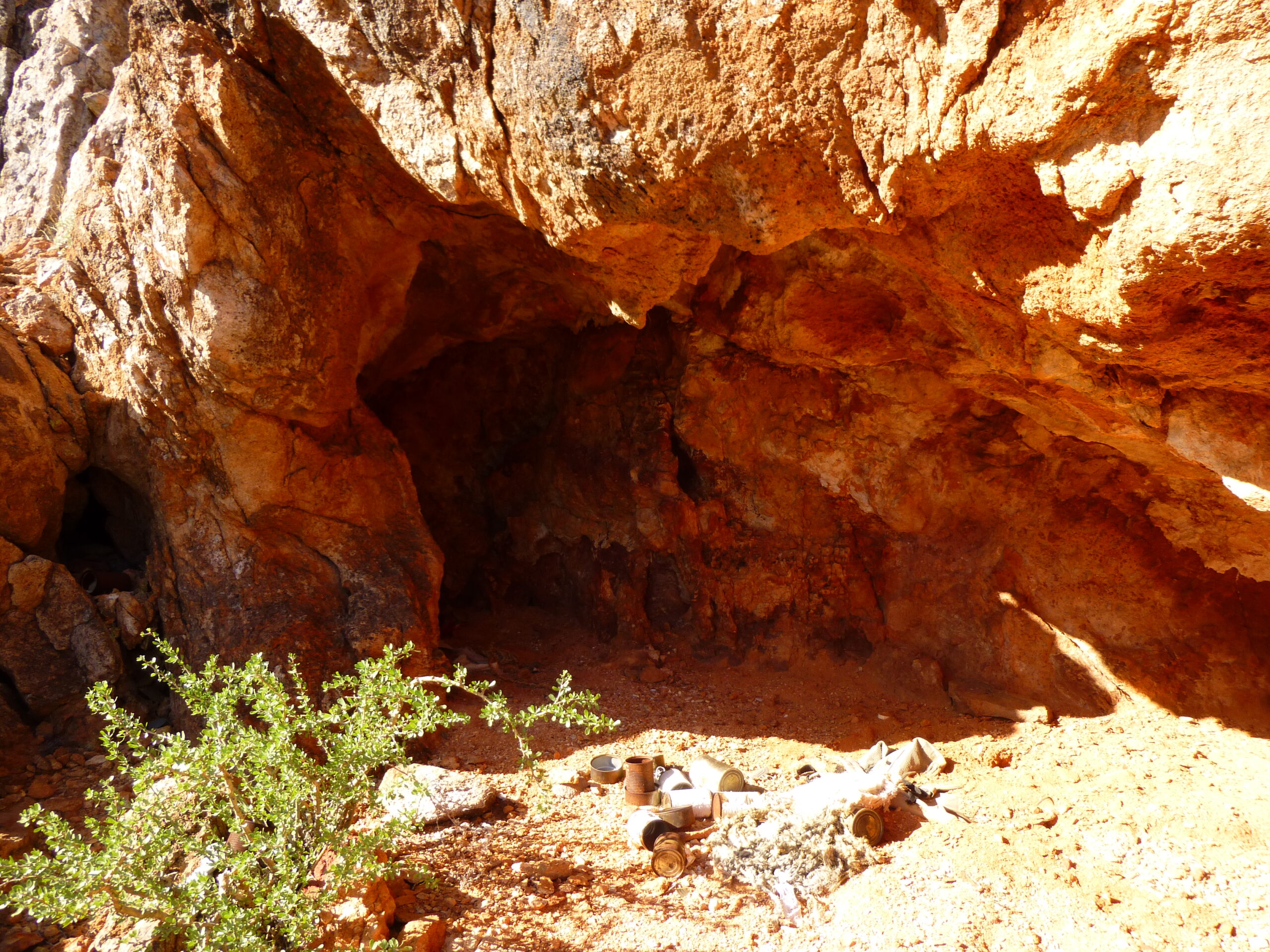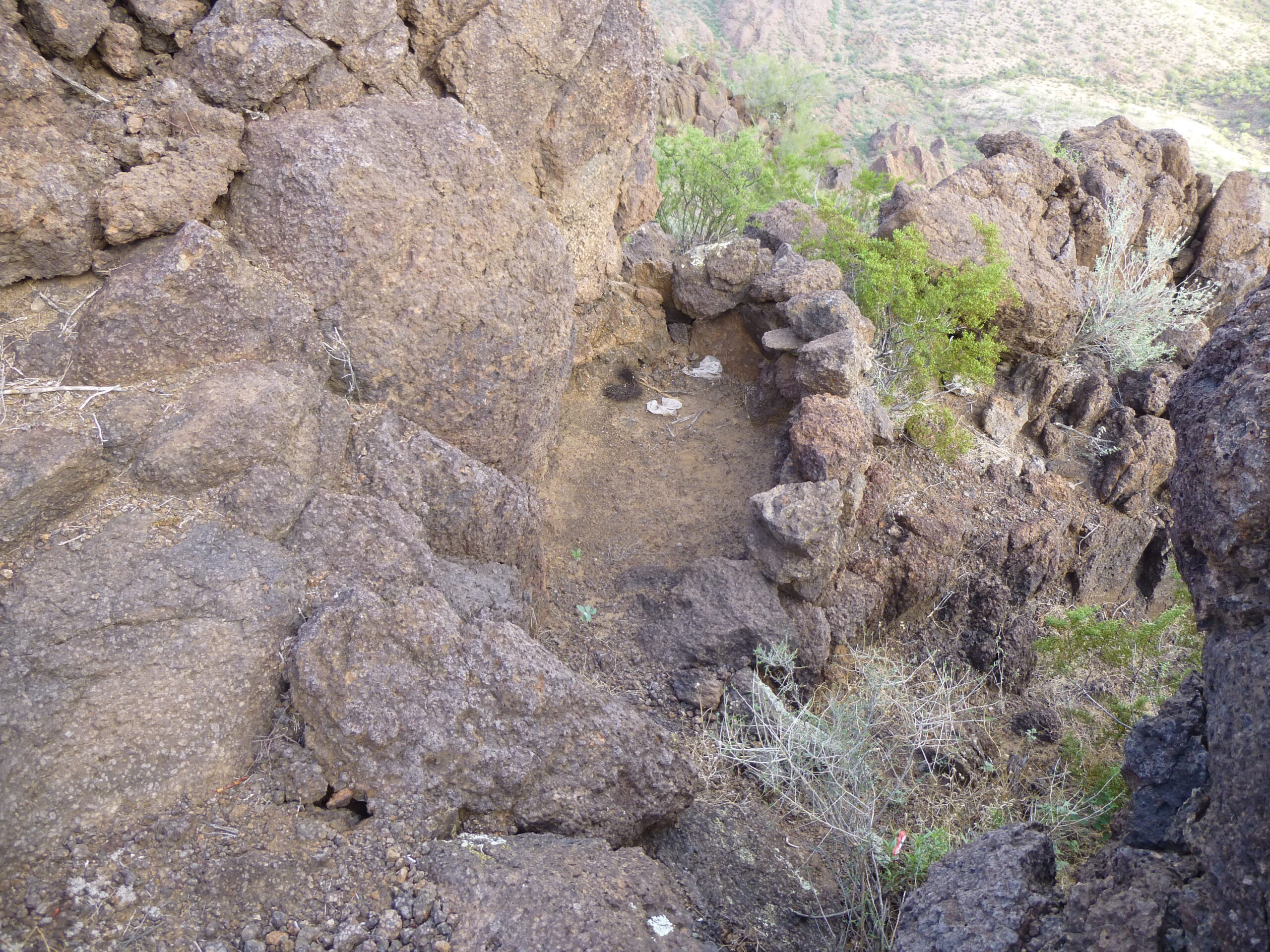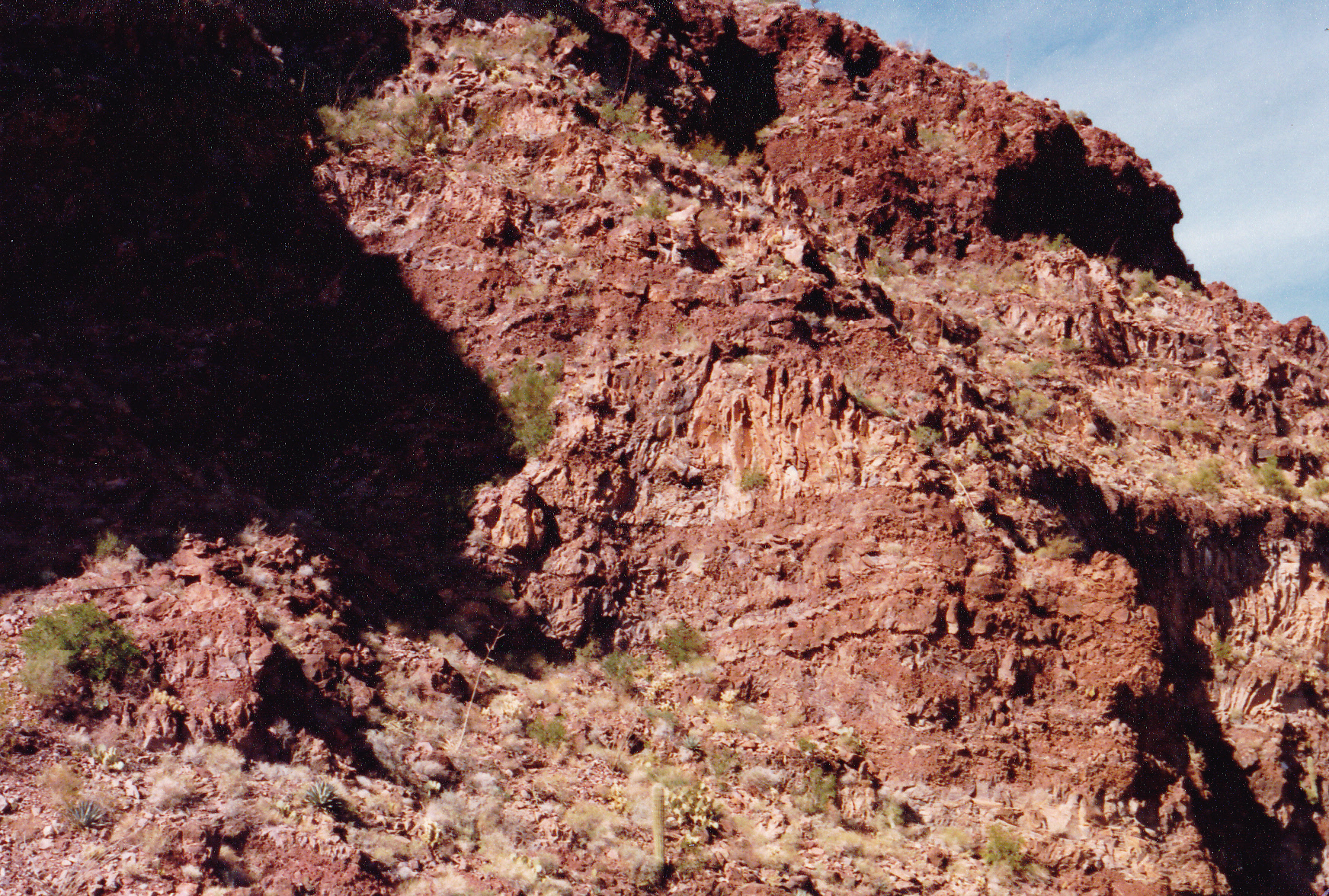The man, the mountain, the map, the myth – so much comes to mind with the word “Kino”. Here in America’s southwest deserts, especially in southern Arizona and northern Sonora, people fondly think of Father Eusebio Francisco Kino as a truly important figure. Regarding the man himself, much has already been written and it would be presumptuous of me to try to add to that. Instead, I direct you to this excellent article from Wikipedia – it is well worth the few minutes it will take you to read, and it will clearly show why he is held in such high regard. He was a real renaissance man who wore many hats: Jesuit, missionary, geographer, explorer, cartographer, mathematician and astronomer.
The state of Arizona has honored him in many ways. In the Phoenix area, we find a Kino Plaza North Shopping Center, a Kino Post Office and a Kino Junior High School, among other features bearing his name. Tucson boasts Kino Hospital, Kino Sports Complex, Kino Parkway and many other features named after him. Closer to the Mexican border, in the Nogales area, we see Kino Park, Kino Springs Dam, Kino Springs Golf Course, Kino Springs Lake and also a community named Kino Springs. There is a Kino Spring at the north end of the Huachuca Mountains. The government has even named a map sheet the Kino Springs Quadrangle which covers some of the features near Nogales. But since this Desert Mountaineer site is one that primarily deals with mountaineering, I’ll now focus on how the name Kino has influenced that.
About a hundred miles west of Tucson as the crow flies sits something called Organ Pipe Cactus National Monument. There is a 7 1/2 minute topographic map entitled “Kino Peak” which covers an area entirely within the boundaries of the monument. This map covers an area 8.6 miles from north to south, and 7.3 miles from east to west, so it’s not very big, only about 63 square miles – that’s less area than many cities. But it’s what lies within the boundaries of that map sheet, this quadrangle, that is impressive – a total of 21 of the nicest mountain peaks that you’ll find anywhere. The paterfamilias of them all is Kino Peak, which deserves a chapter in itself, but I’m going to leave it until last and in the meantime discuss the other peaks on this map.
The mountains of the Kino Peak quad can be divided into 3 groups, as follows: the Puerto Blanco Mountains in the south, with 9 peaks; the Cipriano Hills in the west, with 2 peaks; the Bates Mountains in the north, with 10 peaks. Let’s start in the west.
The Cipriano Hills describe a gentle arc about 7 miles in length, stretching from the newly-formed San Cristóbal Wash in the north down to Cipriano Pass and Aguajita Wash in the south. Not all of these Hills lie within the Kino Peak quad, but about two-thirds of them do. We find 2 true summits on our quad – the high point of the group, and a lesser peak to the north. Guadu Benchmark, elevation 2,604 feet, is the highest point. Fifteen-plus peakbaggers have climbed it, as it’s only a mile and a half trek from a road to the east. Being the high point of a named group of hills is somewhat of a draw, but even more so is the fact that it has over a thousand feet of prominence. If you click on the link for each peak, you will be able to see a picture of it, which I strongly recommend. By the way, Cipriano is a Spanish word which translates as Cyprian, or someone from Cyprus. I don’t know who named these hills or when.
The other summit in the group is Peak 2315. This one is rarely visited. In early 2015, I approached it from the north. A vivid recollection I still have is walking through an area covered in tall weeds and stepping into a hidden hole, then doing a face-plant on to the desert floor. It’s amazing how quickly the ground can rush up to meet your face.
The group of 9 peaks in the Puerto Blanco Mountains is more exciting. The name means “white door” or “white gate”. Over the years, countless indocumentados have streamed across the Mexican border, only half a dozen miles to the south, and made their way through this range. They cross the La Abra Plain to reach the hidden fastnesses of the Puerto Blancos, where they can regroup and plan their next move north.
Peak 1932 is a bit of an outlier, sitting at the extreme southwest corner of the group. This gentle peak is an easy walk-up. Peak 2059 sits a few miles to the east of 1932, and it was climbed only once before I got there, a full 17 years before my 2015 visit. Peak 2011 sits a mile to the east of the long-abandoned Golden Bell Mine and has been climbed by the undocumented as well as a few peakbaggers. Move another mile to the east and you’ll find yourself atop Peak 2296, a steep-sided mountain deeper into the Puerto Blancos. Sadly, signs of border-crossers are everywhere around here, both trails they have created and trash they have left.
Travel another mile to the east and you come to Peak 2675. This steep beauty is the second-highest peak in the range (the highest is Pinkley Peak, which is outside the boundaries of the Kino Peak quad and is farther east). Finally, after more than 20 years, the peak has seen another ascent. Less than a mile to the northeast of it can be found Peak 2435, which sits just south of the road called Puerto Blanco Drive. The top of this peak makes a good lookout point for Bad Guys wanting to keep an eye on Border Patrol traffic passing by on the road below, because there’s a cave up there where they can hole up as long as is needed.
Peak 2435 is in an interesting location. On its western flank is the origin of Aguajita Wash, which flows about 15 miles until it crosses the border into Sonora. A mile and a half later, it is swallowed up by the Río Sonoita, a beleaguered stream indeed. On the eastern slopes of the peak we find the source of San Cristóbal Wash, which flows 106 miles through the harshest desert to finally meet the Gila River. When I say “flow”, of course my regular readers know that these washes are bone-dry 99% of the time.
That leaves us with 3 peaks in the Puerto Blanco Mountains yet to discuss. Each of them is situated just north of the road (which can be seen if you click on the link for Peak 2435). Once you have clicked on any of the links to the peaks, if you click on the small map, it will open up a full-screen map. Peak 2523 rises directly up from the road, and 700 feet of steep climbing later you’ll stand on its summit. This is another excellent vantage point to monitor Border Patrol activity on the road below from an eyrie like this one created by border-crossers.
Less than a mile to the northwest of Peak 2523 sit two more peaks. Both Peak 2090 and Peak 2263 sat there for almost 20 years after their first ascents before they were visited again.
That takes care of the 9 peaks of the Puerto Blanco Mountains that fall within the confines of the Kino Peak quad. Now we’ll move on to the Bates Mountains, where we’ll get to the really good stuff – I’ve saved the best for last. These peaks are the hardest to get to and are the hardest climbs of the lot. Let’s continue north from those last 2 peaks we discussed.
Peak 2541 is out there, far enough away from anything that it wasn’t climbed until the spring of 1998 by two of the most prolific peakbaggers in history – Bob Martin and Bob Packard. Seventeen years later I came along, and it’s still waiting for a third ascent.
Peak 2974 is an oddity. On 4 separate occasions it has been climbed, and in nearly every case the only reason it was visited at all is because it is along the ridge from a bigger, nearby peak which is a much more attractive draw, namely Peak 3019. On the summit of 2974 I found this rock shelter that Bad Guys had made, along with an empty tequila bottle, a battery for powering their 2-way radios and other cast-offs.
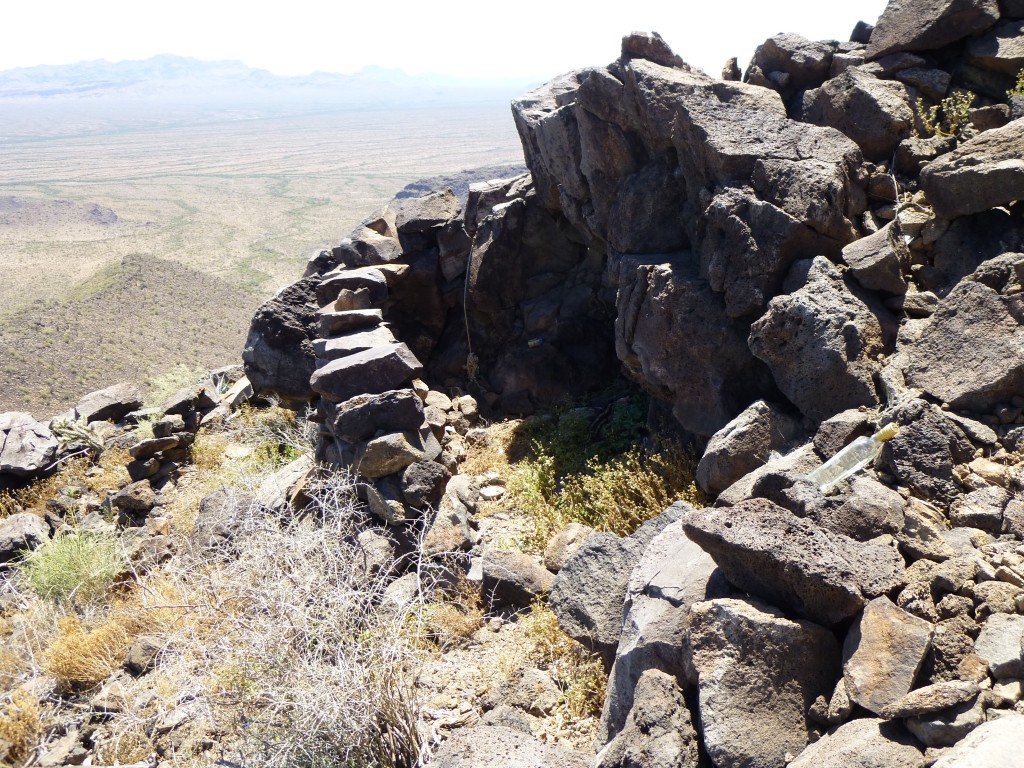
Okay, let’s talk about Peak 3019. This peak is so bloody far out there that there’s no easy way to reach it. Most climbers have approached it from Highway 85, a trek of about 11 miles one-way. First climbed back in 1998 by Packard and Martin, it wasn’t visited again until Paul McMichael and I went there in 2010 on a real death march, approaching it from the north. Eleven climbers are known to have stood on its summit. The only reason it’s been such a draw is the fact that it falls into the category of what is called a 1K prominence peak, meaning it has over a thousand feet of prominence.
The day Paul and I climbed it, two things stand out clearly in our minds from that day. The first is that we saved the life of a Mexican man who had been abandoned by his group of border-crossers and was dying in the remote desert. The second is that once we had summited, we bailed off the peak down its west side. It was a drop of 1,500 vertical feet to the valley below, most of it down a slope of 45 degrees and through many cliff bands of serious Class 3.
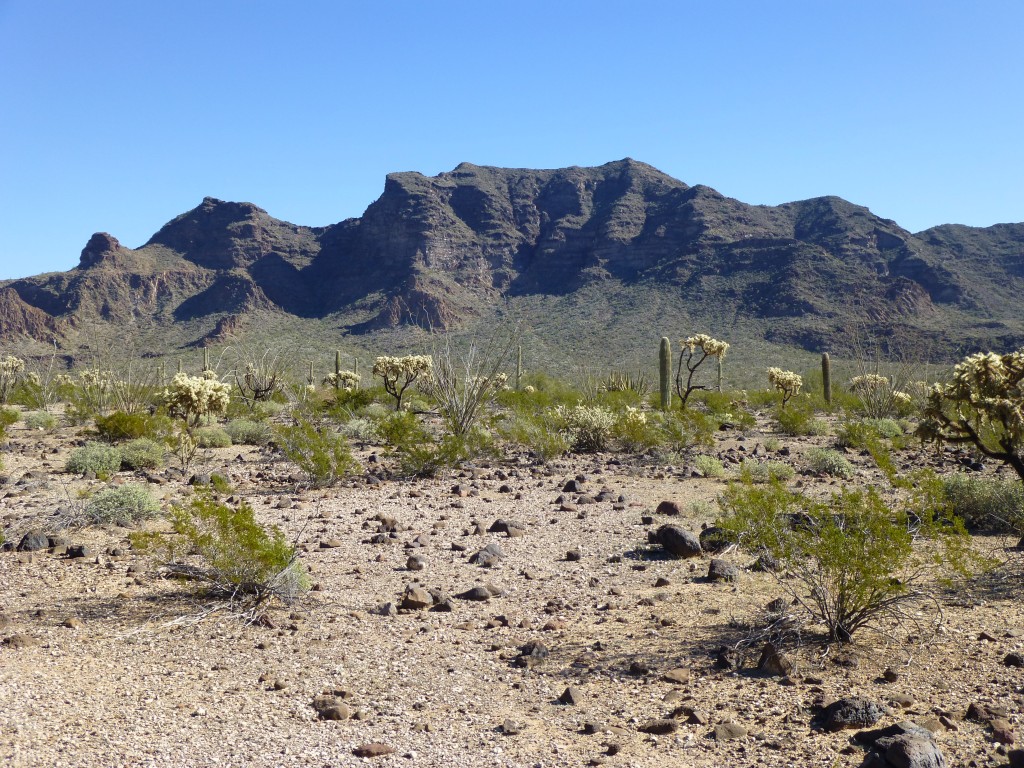
The west side of Peak 3019
If you look at the above photo, see the long flat-looking summit ridge on the skyline in the middle of the photo. The highest point is at the right end. From that point, we descended towards the camera down the ridge which angles down slightly to the left and is in shadow on the left side and in the sun on the right side. It was a grueling experience.
A mile northeast of Peak 3019 sits another of the Bates Mountains summits, namely Peak 2867. It too has only seen 2 ascents, because it’s just so damn far from anything. One of the lower peaks which can be found in this quad is Peak 2356. Same story – twice climbed, forgotten and remote on the east side of the range.
Moving a bit farther north, we come to Peak 2919. This big bruiser has seen a couple more ascents than the previous two, mainly because it has almost a thousand feet of prominence, making it a bigger draw. Something caught my eye on the north ridge of this one – maybe it was the heat starting to work on my brain, but it looked like a huge face. See it, filling the left half of the picture? The nose, and below it a massive fold of rock forming the lip, or perhaps a drooping moustache. Above the nose, the dark rock forming a cap, or perhaps hair. He is facing to the right, and is the height of a 50-story building. Okay, maybe it’s just me, but I thought it was pretty cool.
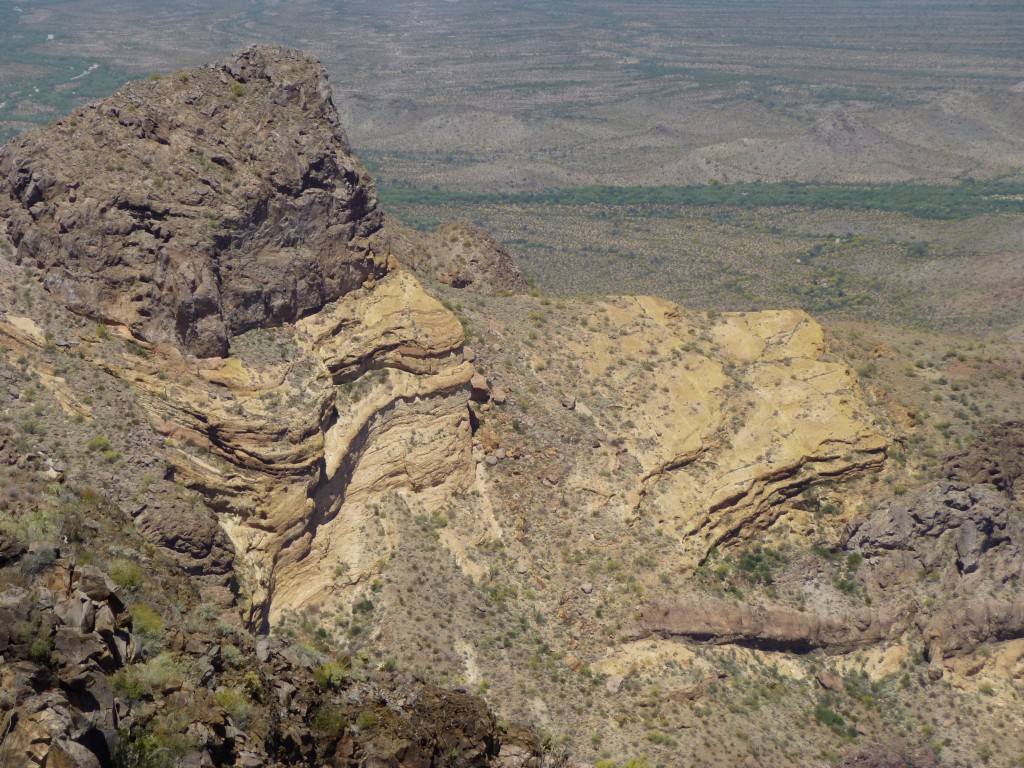
Near the northern edge of this map sheet lies Peak 2678. Once again, because it is so far from anything, it appears to have only been climbed twice, by the usual suspects.
Along much of the eastern edge of this map sits the Valley of the Ajo. There, we find one more peak, somewhat of an outlier of the Bates Mountains, namely Peak 2130. It was climbed in 2000 and 2015, and lo and behold, a recent ascent done on December 9th of 2023 by a climber en route to climb Peak 3019. Makes sense, it is kind of along the way.
There are only 2 peaks left on this map yet to discuss. Peak 2848 can be found in the northwest corner of the map, on the west side of the Bates Mountains. It too is so far removed from any trailhead that only three peak-baggers have ever bothered to go there: Bob Packard in the year 2000; Bob Martin in 2001; Yours Truly in 2015.
Which brings us to the namesake of this map sheet – Kino Peak. It is the highest mountain on the map; it is hard to reach; it is the most difficult climb of them all. It towers almost 200 feet higher than anything else on the quad. This imposing peak was first climbed by the Rock Climbing Section of the San Diego Sierra Club back on February 17th of 1952. My friend Barbara Lilley was one of the group that made the first ascent. She thinks that they drove in from the west and got fairly close to the peak before starting on foot. They brought a rope with them but did not use it. They did leave a register. It wasn’t until 10 years later that the US Geological Survey landed on the summit by helicopter and left the survey marker called Tesmo.

It wasn’t until 1965 that we know of a second ascent. My turn didn’t come until 1987. Even when I climbed it, there was still a mystique about Kino Peak, and the rumor was that fully half of those going in to try the climb did not succeed in reaching the summit. Apparently the problem was that some confusion would arise as to the exact route to take. Someone (I can no longer remember who it was) told me that the trick was to climb up to a smaller bump (about 2,890 feet elevation) to the northeast of the summit and set yourself down and study the northeast face of the peak, trying to decide the best route to take up through the 300-or-so feet of rotten cliffs to reach the summit ridge. Well, that is exactly what I did, with the help of binoculars – I took my time and plotted a route that looked like it would work. Here is a photo I took that day which shows the messy terrain that needed to be climbed.
Current thinking is that the climb is Class 3. When I did it, there were no markings or cairns that showed the way, so you were really on your own. Anyway, I made it up okay and was mighty pleased that I did. It took me 5 hours from where I’d started, at Bates Well to the north, to reach the summit. I spent an hour on top, then 3 hours on the return trip back out to Bates Well.
A popular peak-bagger website, Lists of John, keeps tabs of climbers who have summited, and it’s surprising how seldom the peak is climbed. Here are the ascents we know of for certain from that site, showing how many climbers reached the summit:
1952 – first ascent; 1965 – 1 climber; 1966 – 1 climber; 1973 – 2; 1981 – 1; 1982 – 1; 1987 – 1; 1988 – 2; 1989 – 2; 1990 – 2; 1991 – 1; 1992 – 1; 1993 – 2; 1994 – 5; 1995 – 1; 1997 – 1; 1998 -1; 1999 – 1; 2000 – 2; 2006 – 2; 2009 – 1; 2013 – 1; 2016 – 3; 2018 – 2; 2019 – 1; 2020 – 2; 2022 – 1; 2023 – 3
Another website that tracks climbers is Peakbagger.com, which shows additional years in which the peak was climbed: 1964, ’68, ’78, ’83, ’86, 2011, ’14, ’15, ’17, ’21 and 2024. There has been a definite uptick in ascents in recent years, and that’s good to see – it’s a very worthy peak.
In early 2015, after my descent of nearby Peak 2848, I found myself on the desert floor about 2 miles south of Kino Peak. I turned around and looked back to the north and saw this amazing rocky tower, but it took me a few moments to realize what I was looking at.
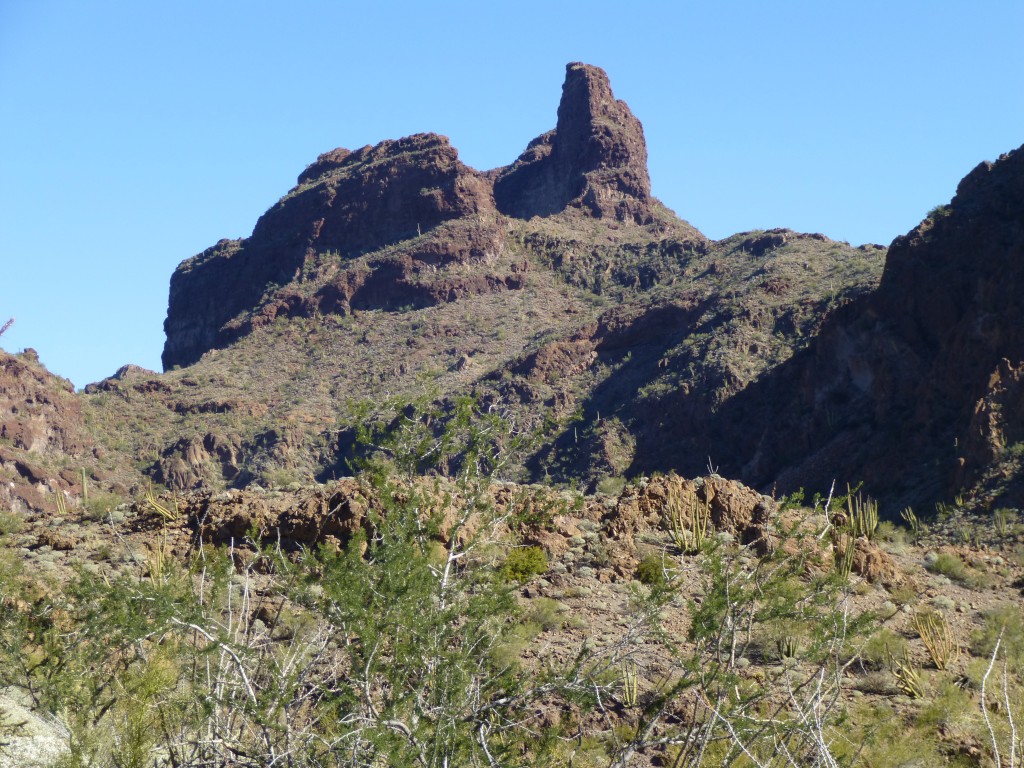
It was Kino Peak, seen from the south, a view most people will never get. It clearly shows how narrow and steep the peak is along its north-south summit ridge. It’s easy to see how everyone climbs it the way they do, as any other route up the crumbling rock is out of the question.
So there you have it, Folks. An amazing man gave his name to an amazing peak which in turn lends its name to a wonderful map sheet full of great peaks. Thanks for coming along to keep me company.

